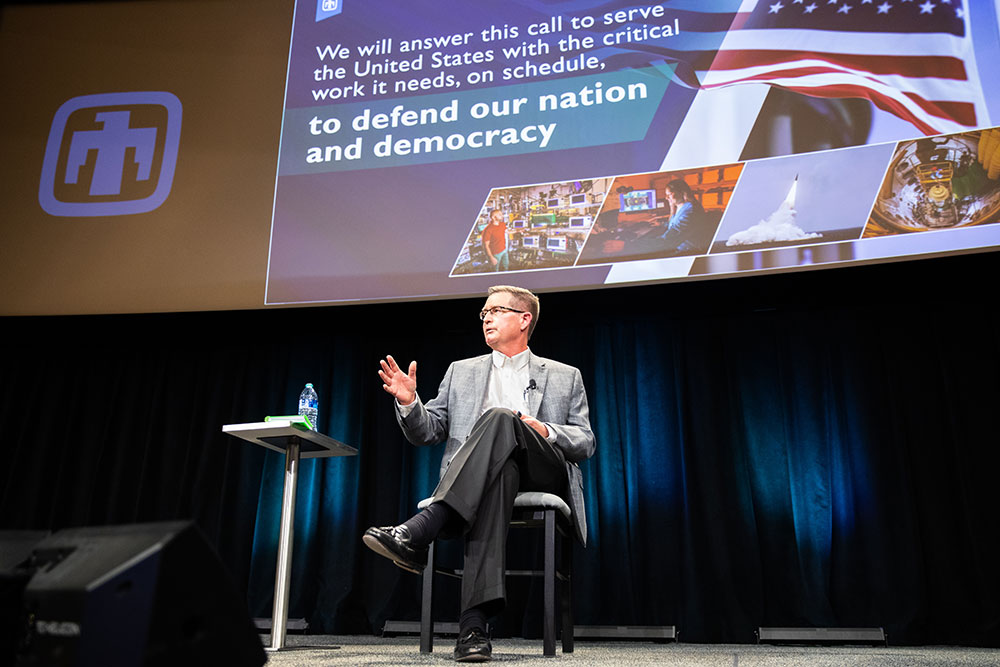Labs director urges workforce to focus on nuclear programs amid Russia, China nuclear acceleration

Sandia Labs Director James Peery urged the workforce during an all hands meeting last week to accelerate nuclear weapons modernization as China multiplies its arsenal and Russia threatens nuclear war.
“The nuclear expansion is unlike anything since the beginning of the atomic age,” he said. “There are continued discussions going on about adding new things to the stockpile beyond the ongoing modernization programs. These discussions are going on because our adversaries are marching very quickly to adding new capabilities.”
The DOE has asked Sandia to increase its modernization efforts in response to how quickly China has expanded its stockpile, James said during the June 23 presentation while outlining the nuclear landscape globally and emphasizing that Sandia must quickly advance its weapons work to maintain an effective nuclear deterrent.
To drive the point home, James shared a clip of Adm. Charles Richard, head of U.S. Strategic Command.
“Two years ago, the great debate was whether China was going to double its stockpile by the end of the decade. That’s already happened while I’ve been the commander of U.S. Strategic Command,” said Richard, speaking to the Senate earlier this year. “This is easily the biggest expansion in China’s history and rivals the biggest expansion of any nation in history, including us and the Soviet Union back in the early ’60s.”
James spoke about the importance of staying on schedule. He said the nation is asking Sandia to quickly modernize nuclear weapons on a fixed budget, so it is important to negotiate requirements to meet deadlines.
“This Lab absolutely hums when requirements are negotiable,” he said.
One of the biggest roadblocks to achieving these outcomes is lack of experienced personnel. James challenged the workforce to think creatively about solutions. Some ideas included partnering with outside organizations, like other national laboratories, to lighten the load of Sandia staff so they can focus resources on nuclear deterrence work. He also suggested recruiting staff internally to contribute their expertise to the core mission and embracing peer review by outside organizations. Lastly, he encouraged experienced staff to mentor new hires. James said Sandia is updating its policies to rehire retirees and increase expertise in the workforce.
There are many opportunities for staff outside of nuclear weapons groups to contribute their capabilities to the Labs’ primary mission. Asking Sandians to think of how they could help the effort whether they worked in Nuclear Deterrence or not, James reflected on his personal experience earlier in his career while working in Sandia’s shockwave physics group.
“When I got my clearance, my supervisor sat me down and said ‘You know, James, we brought you in to write this rad-hydro code, but there will be times when the nuclear weapons program needs your help, and you’re going to stop writing that rad-hydro code, and you’re going to go help them. Until you’re done, you’re not going to go back to writing that rad-hydro code,’” James said. “Just as predicted, it happened three or four times in my technical career at the Laboratory.”
During this time, James worked on devices that contain explosive neutron generators tests, helped resolve an issue on a fire set and analyzed the safety of a nuclear device. “This was some of the most rewarding work that I got to participate in. I’m very proud of that work,” he said.
At the end of his presentation, James invited questions from the audience. In response to questions, he acknowledged concerns about supply chain delays and offered ideas to engage staff from other organizations in the nuclear programs. Using an example of needing electrical engineers, he suggested that rather than filling all open positions, which is unlikely to happen soon, Labs leadership may ask other internal organizations if they are willing to do electrical engineering work in service of the nuclear programs.
James will host a Q&A session on July 18 from 2-3 p.m. to answer questions and ideas from the workforce that may arise after reflecting on the messages he shared last week.
“There’s no way we can get this done without all of us,” James said. “This is a really critical time for the Laboratories and a critical time for the nation.”